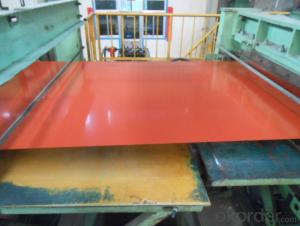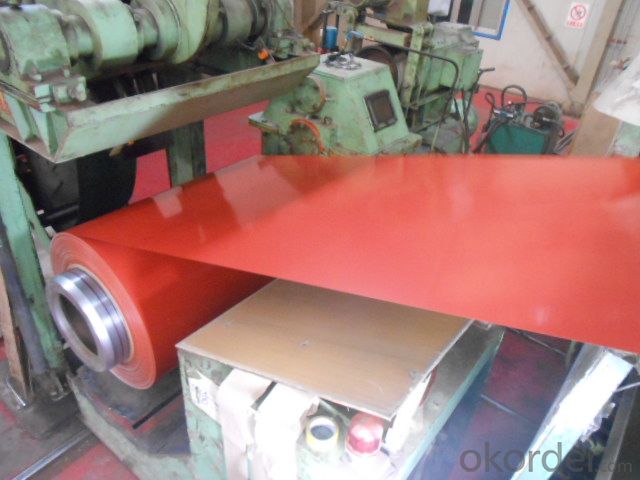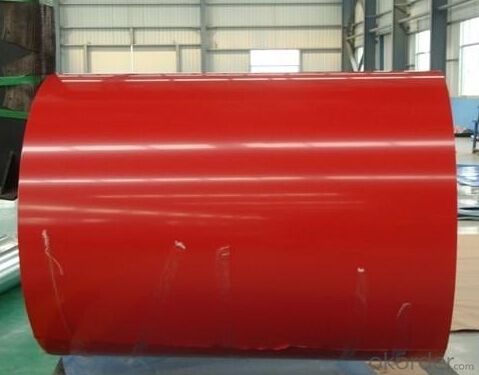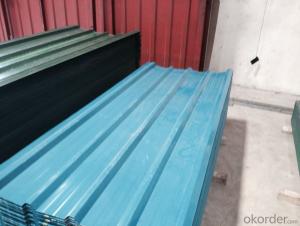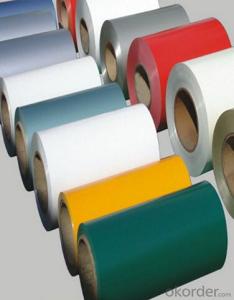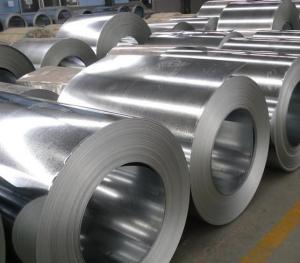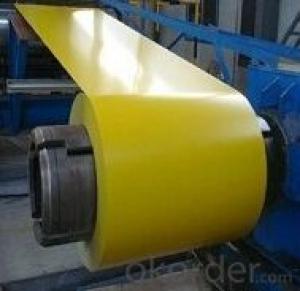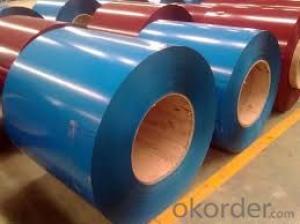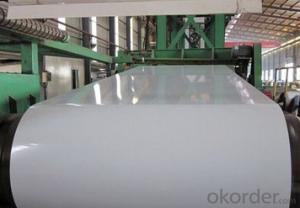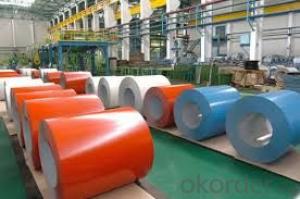PPGI prepainted galvanized steel coil color coated steel coil
- Loading Port:
- Tianjin
- Payment Terms:
- TT OR LC
- Min Order Qty:
- 25 m.t.
- Supply Capability:
- 10000 m.t./month
OKorder Service Pledge
Quality Product, Order Online Tracking, Timely Delivery
OKorder Financial Service
Credit Rating, Credit Services, Credit Purchasing
You Might Also Like
PPGI 0.16-0.6mm 700-1250mm various color/10 year's experience /SGS
Product Description :
| Raw material | SGCC, SPCC, DC51D, SGHC,A653 |
| Certificate | ISO9001.ISO14001.OHSAS18001 |
| Thickness | 0.16mm-0.7mm |
| Width | 1250mm or under |
| Tolerance | thickness+/-0.01mm |
| Surface treatment | galvanized / galvalumized steel sheets |
T Bending (top-coating) T Bending (back-coating) | ≤3T ≤4T |
| Anti-MEK Wiping | ≥100times |
| Zinc coating | 40-180g |
| Type of coating structure | 2/1 or 2/2 coating, or customized |
| Standard | GB/T12754-2006, GB/T9761-1988, GB/T9754-1988, GB/T6739-1996, HG/T3830-2006, HG/T3830-2006, GB/T1732-93, GB/T9286-1998, GB/T1771-1991, GB/T14522-93 |
| Color | customized |
| Application | Building industry ,structural use, roofing, commercial use ,household appliance,industry facilities,office buildings |
Our advantage :
1. Competitive price:
We produce resin and paint by ourself, which greatly reduce our cost!
2. Materials:
All color Steel Sheets are made of high-quality raw materials.
3.Certificate:
Our products are certified by TUV, ISO9001:2008,ISO14001:2004 etc.
4. Productivity:
We have three large-scale production line, to guarantee all your orders will be finished in earlist time
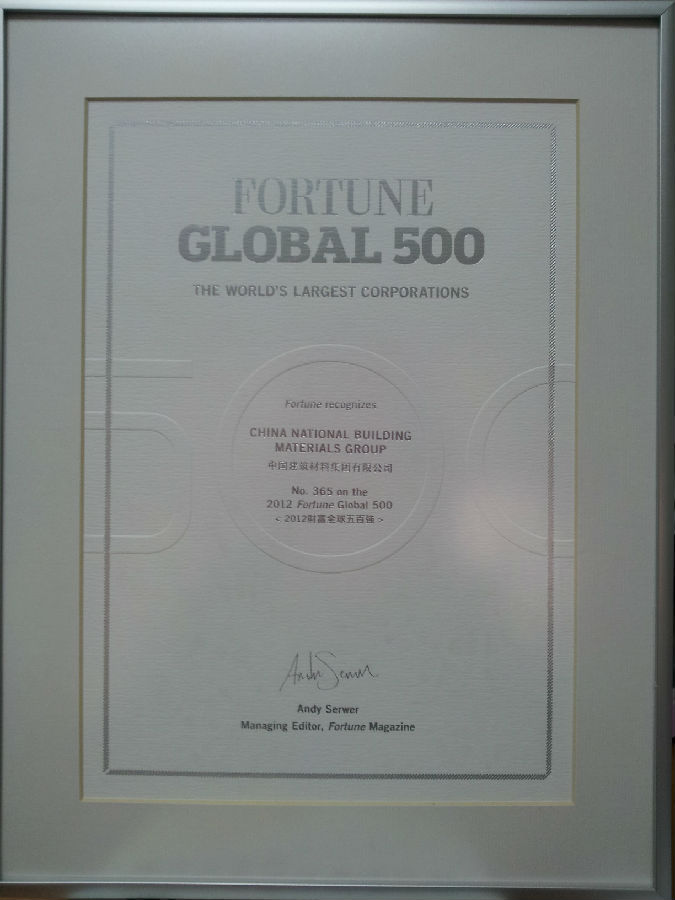
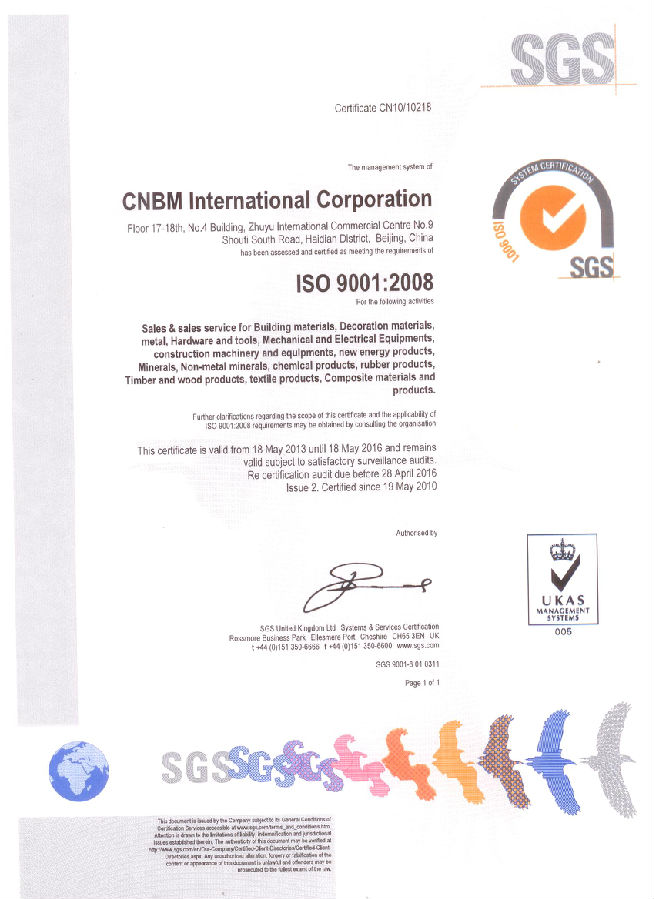
- Q: How is steel sustainable as a building material?How is wood sustainable as a building material?
- Wood as it comes from trees which are in nature.
- Q: If steel content is too cheap, what content should I be looking for? I don't think I could find something like a VG-10 here...
- I am a former chef and have used Chinese chefs knives, different types from cleavers, even french knives, they are mostly carbon steel, and are made with a cold forged process, they are as good as the European knives and are marketability cheaper, I have one a french knife a 8 one with a green non porous handle. I like it, it is light weight and very well made, and keeps an edge quite well, just look for the better type available.
- Q: 911 conspiacy theorists. Can fire melt steel?
- So does fuel also generate timed explosions that were heard by firemen? Why do we see melting steel that looks like thermite burning? Does the jet fuel also destroy the entire 80 stories of steel support structure as well? (This is required to account for the free-fall speed of the collapse of three buildings. That's right, three buildings collapsed at near free-fall speeds in NYC in the WTC complex.) The government's conspiracy theory is totally inconsistent with the facts. The only theory that has coherence at the moment is the demolition theory presented by Professor Steven Jones of BYU (Physics). I've seen no credible challenges to the 13 points he presented in an academic paper on this topic. I'd very much like to see a credible explanation for the free-fall collapse of all three buildings.
- Q: I thought it was STAINLESS STEEL! I have stainless steel can openers spatulas that are rusty. What's up with that? did you know that braces on people's teeth are made of stainless steel? That's why they call people metal-mouth. I used to have braces.
- You can rub the rust off with anything, from steel wool to Ajax. Although if you've previously used steel wool to clean it, that could be why it rusts. We had that problem manufacturing stainless steel railing and had to put it together on an aluminum table and polish welds with grinding wheels that never touched steel. What rusts are steel particles picked up on the stainless surface. Another possibility is that some stainless is more magnetic and usually also heat-treatable. It has just enough chrome in it to classify as stainless but can get minor surface rust. Not nearly as much as plain steel, though. Use a scouring powder like Zud or Barkeepers Friend and a cloth or sponge to polish if it's a sheetmetal surface rather than a bar grille, because these have oxalic acid and no bleach. They don't leave corrosive traces of chlorine behind. In fact, oxalic acid reduces rust to iron powder. Which is really neat if you need to clean a small rusty item--stir one of these powders into water, drop in the rusty piece and check it from time to time. Rinse off any abrasive powder, dry it well and oil it. When the rust is gone, it leaves a fine matte finish behind.
- Q: pros and cons of stainless steel and carbon steel swords
- Carbon is what samurais added to their swords to make them super strong. The iron ore was cooked in coal for days; the coal adds the carbon. Too much carbon or too little carbon is a bad thing so it was a very important process. I'd have to go with a sword with carbon.
- Q: How long do steel coils last?
- The lifespan of steel coils can vary depending on various factors such as the quality of the steel, the conditions in which they are stored or used, and the specific application for which they are being used. Generally, high-quality steel coils can last for several years to several decades before showing signs of deterioration or wear. However, it is important to note that steel coils can be susceptible to corrosion if not properly maintained or protected from moisture or harsh environmental conditions. Therefore, regular inspection, maintenance, and appropriate storage or usage practices are crucial in maximizing the lifespan of steel coils.
- Q: How are steel coils used in the production of metal ceilings?
- Steel coils play a vital role in the manufacturing of metal ceilings. Typically composed of high-quality steel, these coils serve as the fundamental material for fabricating metal ceiling panels. To commence the process, the steel coils are uncoiled and fed into a roll forming machine. Gradually, this machine shapes the steel into the desired profile for the ceiling panels. The coils pass through a series of rollers that bend and mold the steel into the necessary dimensions and design. Once the steel has taken its desired shape, it is cut into individual panels of the required length. These panels then undergo various finishing processes, including surface treatment, painting, or powder coating, to enhance their appearance and durability. Steel coils are the preferred choice for producing metal ceilings due to their exceptional strength and rigidity. They establish a robust foundation for the ceiling panels, ensuring their longevity and resistance to deformation. Additionally, steel coils offer superior fire resistance, making them a safe option for commercial and industrial buildings. Apart from their structural advantages, steel coils also allow for a wide array of design possibilities. The malleability of steel enables manufacturers to create intricate patterns and textures on the surface of the ceiling panels, adding aesthetic appeal and enhancing the overall interior design. In summary, steel coils are an essential component in the production process of metal ceilings. They possess the necessary strength, durability, and versatility for crafting high-quality and visually pleasing ceiling panels utilized in various commercial and residential settings.
- Q: How are steel coils used in the manufacturing of industrial pumps?
- Steel coils are used in the manufacturing of industrial pumps as they provide a strong and durable material for constructing pump components such as casings, impellers, and shafts. The coils are typically cut, shaped, and welded to create the necessary parts, ensuring the pumps can handle high pressures and harsh operating conditions in various industries.
- Q: How are steel coils used in the production of elevator components?
- Steel coils are used in the production of elevator components to manufacture various structural and mechanical parts. These coils are typically formed, shaped, and cut to create components such as elevator guide rails, brackets, frames, and support structures. The high strength and durability of steel make it an ideal material for these components, ensuring the safety and reliability of elevators.
- Q: What are the common uses of cold rolled steel coils?
- Cold rolled steel coils have a wide range of common uses such as in automotive manufacturing, construction, appliances, furniture, and general engineering applications.
Send your message to us
PPGI prepainted galvanized steel coil color coated steel coil
- Loading Port:
- Tianjin
- Payment Terms:
- TT OR LC
- Min Order Qty:
- 25 m.t.
- Supply Capability:
- 10000 m.t./month
OKorder Service Pledge
Quality Product, Order Online Tracking, Timely Delivery
OKorder Financial Service
Credit Rating, Credit Services, Credit Purchasing
Similar products
Hot products
Hot Searches
Related keywords
